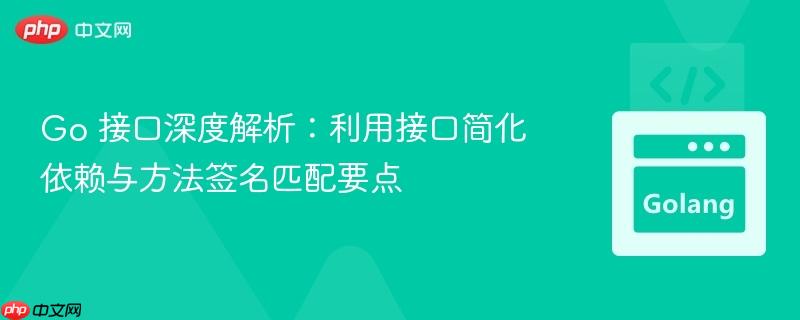
本文深入探讨go语言中利用接口简化依赖管理的实践。通过一个具体的mongodb驱动抽象案例,我们揭示了在定义接口时,其方法签名必须与实现类型的方法签名完全一致的关键要求。特别是,当返回类型是另一个接口时,实现类型的对应方法必须直接返回该接口类型,而非返回一个恰好实现了该接口的具体类型。理解这一机制对于有效利用go接口实现松耦合和可测试性至关重要。
理解 Go 接口与依赖抽象
在Go语言中,接口是实现抽象和解耦的强大工具。开发者常希望通过接口来隔离业务逻辑与具体的外部依赖(如数据库驱动、HTTP客户端等),从而提高代码的可测试性和可维护性。一个典型的场景是,为了避免在多个业务模型中直接引入特定的数据库驱动包(例如 mgo),我们定义一套自己的接口来代表数据库操作。
考虑以下场景:我们希望为MongoDB操作定义一套抽象接口,以避免在业务逻辑中直接耦合 mgo 包。
package dota // 假设这是我们的业务包
type m map[string]interface{}
// collectionSlice 接口代表一个查询结果集,可以获取单个结果
type collectionSlice interface {
One(interface{}) error
}
// collection 接口代表一个数据库集合,支持增改查操作
type collection interface {
Upsert(interface{}, interface{}) (interface{}, error)
Find(interface{}) collectionSlice // 注意这里返回 collectionSlice
}
// database 接口代表一个数据库实例,可以获取集合
type database interface {
C(name string) collection // 注意这里返回 collection
}
// FindItem 是一个使用抽象 database 接口的函数
func FindItem(defindex int, d database) (*Item, error) {
// 实际业务逻辑,通过接口 d 进行数据库操作
// 例如:d.C("items").Find(m{"defindex": defindex}).One(&item)
return nil, nil // 简化示例
}
// Item 结构体,代表一个数据模型
type Item struct {
Defindex int `bson:"defindex"`
Name string `bson:"name"`
}在实际应用中,我们可能在 main 包或 controller 包中调用 FindItem 函数,并传入一个具体的 mgo.Database 实例。
package controllers // 假设这是我们的控制器包
import (
"context" // 假设 ctx 包含数据库连接
"go.mongodb.org/mongo-driver/mongo" // 现代 Go 应用通常使用 mongo-driver
// "gopkg.in/mgo.v2" // 原始问题中使用的 mgo 包,这里以 mongo-driver 替代
"your_project/dota" // 引入业务包
)
// 假设 ctx.Database 是 *mongo.Database 类型
// item, err := dota.FindItem(int(defindex), ctx.Database) // 编译器报错然而,当我们尝试将 *mongo.Database 类型(或原始问题中的 *mgo.Database)作为 dota.FindItem 函数的 database 参数传入时,编译器会报错:
cannot use ctx.Database (type *mongo.Database) as type dota.database in function argument:
*mongo.Database does not implement dota.database (wrong type for C method)
have C(string) *mongo.Collection
want C(string) dota.collection这个错误信息清晰地指出了问题所在:*mongo.Database 类型并没有完全实现 dota.database 接口,具体是 C 方法的签名不匹配。
Go 接口的严格匹配规则
Go语言中接口的实现是隐式的,只要一个类型拥有接口中定义的所有方法,并且这些方法的名称、参数列表和返回类型都与接口定义完全一致,那么该类型就自动实现了这个接口。这里的“完全一致”是严格的。
回到我们的错误信息:
- *mongo.Database 的 C 方法签名是 C(string) *mongo.Collection。
- dota.database 接口的 C 方法签名是 C(string) dota.collection。
问题出在返回类型上:*mongo.Collection 与 dota.collection 是不同的类型。尽管我们可能希望 *mongo.Collection 能够“被视为” dota.collection,但Go编译器并不会进行这种隐式转换。即使 *mongo.Collection 类型碰巧实现了 dota.collection 接口,在方法签名匹配时,返回类型必须是字面上相同的类型,或者都是接口类型且实现关系成立。
核心要点:
- 方法名称必须一致。
- 参数列表必须一致(包括参数数量、类型和顺序)。
- 返回类型必须一致(包括返回值的数量和类型)。
当接口方法的返回类型是另一个接口时,实现该接口的具体类型的方法,其返回类型也必须是该接口类型,或者是一个能被直接赋值给该接口类型的类型。简单来说,如果你期望返回一个 dota.collection 接口,那么实际实现的方法就必须返回一个实现了 dota.collection 接口的类型。
解决方案:通过适配器模式桥接具体实现与接口
为了解决这个问题,我们需要确保 *mongo.Database 的 C 方法返回的类型,能够适配 dota.database 接口中 C 方法所期望的 dota.collection 接口。这通常通过适配器模式(Adapter Pattern)来实现。
我们需要创建一些包装器(Wrapper)类型,它们将具体的 mongo 包类型封装起来,并对外暴露我们定义的接口。
1. 重新审视并完善接口定义
首先,确保我们的抽象接口能够覆盖 mongo.Collection 和 mongo.Query 的核心操作。
package dota
type m map[string]interface{}
// collectionSlice 接口
type collectionSlice interface {
One(interface{}) error
All(interface{}) error // 假设我们还需要 All 方法
}
// collection 接口
type collection interface {
Upsert(selector, change interface{}) (interface{}, error)
Find(query interface{}) collectionSlice
Remove(selector interface{}) error // 假设我们还需要 Remove 方法
}
// database 接口
type database interface {
C(name string) collection
}
// Item 结构体
type Item struct {
Defindex int `bson:"defindex"`
Name string `bson:"name"`
}
// FindItem 函数保持不变,它依赖于我们的抽象接口
func FindItem(defindex int, d database) (*Item, error) {
var item Item
// 使用抽象接口进行操作
err := d.C("items").Find(m{"defindex": defindex}).One(&item)
if err != nil {
return nil, err
}
return &item, nil
}2. 创建适配器类型
接下来,我们创建适配器类型,让 mongo 库的具体类型能够实现我们的 dota 接口。这些适配器通常放在一个独立的包中,例如 dbadapter,以保持业务逻辑包 dota 的纯净。
package dbadapter
import (
"context"
"go.mongodb.org/mongo-driver/bson"
"go.mongodb.org/mongo-driver/mongo"
"go.mongodb.org/mongo-driver/mongo/options"
"your_project/dota" // 引入我们的接口定义
)
// mongoCollectionSliceAdapter 实现了 dota.collectionSlice 接口
type mongoCollectionSliceAdapter struct {
ctx context.Context
curr *mongo.Cursor // mongo.Cursor 对应查询结果
}
func (mcsa *mongoCollectionSliceAdapter) One(result interface{}) error {
if mcsa.curr.Next(mcsa.ctx) {
return mcsa.curr.Decode(result)
}
return mongo.ErrNoDocuments // 如果没有更多文档
}
func (mcsa *mongoCollectionSliceAdapter) All(results interface{}) error {
return mcsa.curr.All(mcsa.ctx, results)
}
// mongoCollectionAdapter 实现了 dota.collection 接口
type mongoCollectionAdapter struct {
ctx context.Context
collection *mongo.Collection
}
func (mca *mongoCollectionAdapter) Upsert(selector, change interface{}) (interface{}, error) {
// mongo-driver 的 Upsert 是 UpdateOne/UpdateMany 配合 Upsert 选项
// 假设这里只做单文档 Upsert
opts := options.Update().SetUpsert(true)
res, err := mca.collection.UpdateOne(mca.ctx, selector, bson.M{"$set": change}, opts)
if err != nil {
return nil, err
}
return res, nil // 返回 UpdateResult
}
func (mca *mongoCollectionAdapter) Find(query interface{}) dota.collectionSlice {
// mongo.Collection.Find 返回 *mongo.Cursor
cursor, err := mca.collection.Find(mca.ctx, query)
if err != nil {
// 实际应用中需要更好的错误处理
return &mongoCollectionSliceAdapter{ctx: mca.ctx, curr: nil} // 返回一个空的适配器或错误
}
return &mongoCollectionSliceAdapter{ctx: mca.ctx, curr: cursor}
}
func (mca *mongoCollectionAdapter) Remove(selector interface{}) error {
_, err := mca.collection.DeleteOne(mca.ctx, selector)
return err
}
// mongoDatabaseAdapter 实现了 dota.database 接口
type mongoDatabaseAdapter struct {
ctx context.Context
database *mongo.Database
}
func (mda *mongoDatabaseAdapter) C(name string) dota.collection {
// 返回我们封装过的 collection 适配器
return &mongoCollectionAdapter{ctx: mda.ctx, collection: mda.database.Collection(name)}
}
// NewMongoDatabaseAdapter 是一个工厂函数,用于创建适配器实例
func NewMongoDatabaseAdapter(ctx context.Context, db *mongo.Database) dota.database {
return &mongoDatabaseAdapter{ctx: ctx, database: db}
}3. 在应用中使用适配器
现在,在控制器或主函数中,我们可以创建 mongo.Database 实例,然后通过适配器将其转换为 dota.database 接口类型,再传入业务逻辑函数。
package main
import (
"context"
"fmt"
"log"
"time"
"go.mongodb.org/mongo-driver/mongo"
"go.mongodb.org/mongo-driver/mongo/options"
"your_project/dbadapter" // 引入适配器包
"your_project/dota" // 引入业务包
)
func main() {
ctx, cancel := context.WithTimeout(context.Background(), 10*time.Second)
defer cancel()
// 连接 MongoDB
client, err := mongo.Connect(ctx, options.Client().ApplyURI("mongodb://localhost:27017"))
if err != nil {
log.Fatalf("Failed to connect to MongoDB: %v", err)
}
defer func() {
if err = client.Disconnect(ctx); err != nil {
log.Fatalf("Failed to disconnect from MongoDB: %v", err)
}
}()
// 获取具体的 *mongo.Database 实例
mongoDB := client.Database("mydatabase")
// 创建数据库适配器
// 现在 ctx.Database (即 mongoDB) 可以通过适配器转换为 dota.database 类型
abstractDB := dbadapter.NewMongoDatabaseAdapter(ctx, mongoDB)
// 调用业务逻辑函数,传入抽象接口
item, err := dota.FindItem(123, abstractDB) // 编译通过!
if err != nil {
log.Printf("Error finding item: %v", err)
} else {
fmt.Printf("Found item: %+v\n", item)
}
// 示例:插入或更新一个项目
_, err = abstractDB.C("items").Upsert(dota.m{"defindex": 123}, dota.m{"name": "New Item Name"})
if err != nil {
log.Printf("Error upserting item: %v", err)
} else {
fmt.Println("Item upserted successfully.")
}
// 示例:查找所有项目
var allItems []dota.Item
err = abstractDB.C("items").Find(dota.m{}).All(&allItems)
if err != nil {
log.Printf("Error finding all items: %v", err)
} else {
fmt.Printf("Found all items: %+v\n", allItems)
}
}注意事项与总结
- 严格的签名匹配: Go语言接口的隐式实现要求方法签名(名称、参数、返回类型)必须完全一致。这是理解和使用Go接口的关键。
- 适配器模式: 当外部库的类型不直接满足我们定义的接口时,适配器模式是连接两者最常用的方法。通过创建包装器类型,我们可以将外部库的功能适配到我们自己的接口契约上。
- 上下文传递: 在使用 mongo-driver 这类现代数据库驱动时,context.Context 的传递非常重要。适配器在内部调用具体驱动方法时,也应正确传递 context.Context。
- 错误处理: 适配器内部在调用具体驱动方法时,应妥善处理可能发生的错误,并将其向上层业务逻辑传递。
- 接口粒度: 接口的粒度应适中。过大的接口难以实现和测试,过小的接口可能导致接口数量过多,增加管理复杂性。
- 可测试性: 使用接口进行依赖抽象的最大好处之一是提高了代码的可测试性。在单元测试中,我们可以轻松地为 dota.database 接口创建模拟(mock)实现,而无需连接真实的MongoDB数据库。
通过上述方法,我们成功地利用Go接口实现了业务逻辑与具体数据库驱动的解耦,遵循了依赖倒置原则,并提升了代码的灵






























